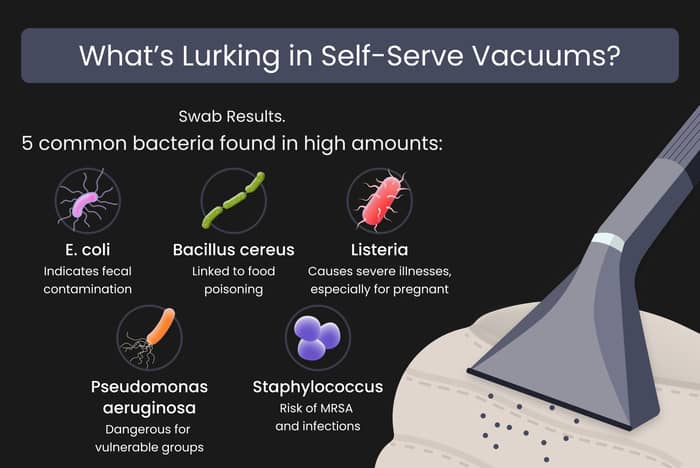The Bacteria on Self-Serve Car Vacuums
Panda Hub commissioned a lab study into the microbes lurking on self serve vacuums, commonly found at car washes and gas stations.

Written by:
Russell Hunter
Reviewed By:
Editorial Team
Published: March 28, 2025
Updated: October 28, 2025
Use AI to summarize this article:
Have you ever seen someone using a self-serve vacuum cleaner to clean their car and wondered just how dirty the vacuums are? Or have you ever used one and wondered what other people were using them for?
To find out just how dirty these vacuums are, the team at Panda Hub commissioned an experiment with an accredited Laboratory and surveyed American car owners to see how many people use them.
By Swab testing Self-Serve Car vacuums, Panda Hub’s shocking study has revealed which microbes are being unknowingly wiped all over people’s car interiors.
Keeping your car interior clean is important; regularly vacuuming your seats and upholstery is all part of a good car cleaning routine. You’ve been in a pinch, or you don’t have a good vacuum at home, it happens. The obvious solution for many is to spend 15 extra minutes at the gas station and vacuum your seats, carpets, and trunk.
But is this decision making your car cleaner?
No, it likely isn’t. While you’re cleaning up dust, debris, and dirt, you’re likely wiping feces particles all over your seats, floor, and trunk. Here’s what we found.

Key Findings - Microbial Lab Analysis of Vacuum Swabs
The following bacteria were found in high amounts on every swabbed self-serve car vacuum:
- Staphylococcus aureus
- Pseudomonas aeruginosa
- Listeria monocytogenes
- Coliforms (including E. coli)
- E. coli (pathogenic strains)
- Bacillus cereus
- Other unidentified coliforms
These bacteria are responsible for serious sicknesses, and all were found in high amounts. Coliforms in high amounts are indicators of feces residue, which is particularly concerning given they'll be wiped all over people's cars. Listeria and E. coli are dangerous if brought into a food preparation environment, which could easily be transferred from cars to groceries.

Key Findings - Self-Serve Vacuum Usage from American Car Owners
- 58% of surveyed car-owning Americans claimed self-serve vacuums were part of their car cleaning routine. From over 212M registered drivers, this would amount to over 123 million Americans.
- 32% of respondents said they would use self-serve car vacuums on a daily or weekly basis. This would amount to over 67 million Americans.

Additional Areas of Concern:
- We surveyed Texan car owners on their car habits, and 15% admitted to eating in their car daily, and an additional 30% on a weekly basis. With up to 45% of Texans eating in their cars, we hope they aren't using these self-serve vacuums beforehand.
- There were 173M Americans using food delivery services in 2024. If you’re eating food transported on car seats or on the floor, you may want to reconsider!
Summary By Swab:
| Swab | Overall Risk Summary | Key Risks |
|---|---|---|
| Swab A | High |
Staphylococcus aureus: Potential for MRSA, can cause serious skin and systemic infections. Pseudomonas aeruginosa: Opportunistic pathogen, dangerous for those with weakened immune systems, can lead to severe respiratory and skin infections. Listeria monocytogenes: High risk for pregnant individuals and immunocompromised, can cause severe illnesses like listeriosis. Coliforms (including E. coli): Presence may indicate fecal contamination; further analysis needed to confirm pathogenic strains. Bacillus cereus: Can lead to rapid-onset food poisoning with vomiting and diarrhea. |
| Swab B | Moderate |
Staphylococcus aureus: Present at lower counts, still a concern for skin and wound infections. Listeria monocytogenes: Moderate risk, particularly for vulnerable groups, associated with foodborne listeriosis. Coliforms (including E. coli): Presence may indicate fecal contamination; some strains can be pathogenic and cause GI issues. Bacillus cereus: Potential for foodborne illness, leading to symptoms like nausea and diarrhea. |
| Swab C | Very High |
Coliforms (including E. coli): High counts indicate significant contamination; pathogenic strains could cause severe gastrointestinal illness. Staphylococcus aureus: High counts, posing a risk for serious infections. Listeria monocytogenes: Significant risk, especially to pregnant women and individuals with weakened immunity. Bacillus cereus: Food safety concern due to its potential to cause food poisoning. Pseudomonas aeruginosa: May pose a risk for those with compromised immunity, can lead to severe infections. |
| Swab D | Moderate / High |
Listeria monocytogenes: Can cause serious infection, especially in at-risk individuals (e.g., pregnant women, immunocompromised). Coliforms (including E. coli): Presence may indicate fecal contamination and possible presence of harmful bacteria. Staphylococcus aureus: Moderate to high risk for wound infections and foodborne illness. Bacillus cereus: Concern for food safety, associated with foodborne outbreaks. Pseudomonas aeruginosa: Potential risk for severe infections in vulnerable individuals. |
| Swab E | Low / Moderate |
Staphylococcus aureus: Present at lower counts, can cause skin and wound infections. Coliforms: Presence may indicate contamination; further analysis is needed to determine if pathogenic strains are present. Bacillus cereus: Low to moderate risk for foodborne illness, can cause vomiting and diarrhea. Listeria monocytogenes: Present at lower counts but remains a significant concern for vulnerable populations. E. coli (pathogenic strains): Potential risk for GI issues, indicating possible fecal contamination. |

Self Serve Vacuum Usage
- 42% of respondents claimed they would use self-serve car vacuums for routine maintenance, which amounts to a potential 89 million American drivers doing the same thing.
- Women are less likely to use Self-Serve Car Vacuums to clean their cars, with 39% saying they would almost never use them, in comparison only 22% of Men would almost never use them.
- 40% claimed they would be likely to use these vacuums to prepare for Christmas, which amounts to a potential 85 million Americans spreading feces particles, E. coli and Listeria all over their cars right before a big event.
What Should You Do?
Well, we would suggest that if you're able to, you vacuum your car at home.
Panda Hub's Lead Detailer, Parham Koukia, says, "Regular, light vacuuming, even with a handheld vacuum, will make a big difference. Make sure to wipe the end of your vacuum attachments down before or after you use them. At home, you could even use a disposable antibacterial wipe, just let them dry before you use them on your car."
Sources
Number of registered American car drivers - Bureau of Transport Statistics
Microbial Swab Analysis - Commissioned by Panda Hub & Conducted by Microchem Lab - ISO 17025 Accredited.
Survey of 500 US Car Owners - Commissioned by Panda Hub & Conducted by SurveyMonkey
Survey of 400 Texan Car Owners - Commissioned by Panda Hub & Conducted by Appinio
